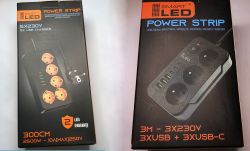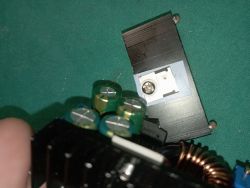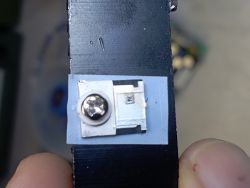FAQ
TL;DR: XL4016 buck board delivers 1.2-35 V at up to 9 A (≈300 W) [Elektroda, TechEkspert, post #17184389]; reverse hookup “will probably blow out the capacitors” [Elektroda, maciek_90, post #17185062] “Such a simple protection will take over all the current” [Elektroda, mariomario, post #17185106] Why it matters: two solder-level fixes turn a €4 module into a safe bench PSU.
Quick Facts
• Input range: 8-40 V DC; output: 1.2-35 V, 0-9 A, ≈300 W [Elektroda, TechEkspert, post #17184389]
• Efficiency: Typical 95 % at 24 V→12 V/5 A (*XLSEMI datasheet*)
• Panel meter DSN-VC288 max supply 24 V (20 mA draw) [Elektroda, TechEkspert, post #17184389]
• Safe meter power above 24 V: add 12 V regulator or isolated DC/DC [Elektroda, TechEkspert, post #17184389]
• Board cost: US $3-5 on AliExpress (2025 listing)
What are the core limits of the XL4016 buck converter?
The board accepts 8-40 V input and produces 1.2-35 V at up to 9 A continuous (≈300 W) when cooled properly [Elektroda, TechEkspert, post #17184389] Efficiency peaks around 95 % at a 2:1 step-down ratio (XLSEMI datasheet).
How do I power the DSN-VC288 meter without destroying it?
Keep the supply to pin 5 below 24 V (some vendors quote 30 V, play safe). When the converter input exceeds 24 V, feed the meter through a 12 V linear regulator or an isolated DC-DC module; leave pin 4 floating if a separate supply is used [Elektroda, TechEkspert, post #17184389]
What is the simplest reverse-polarity protection that won’t waste volts?
Parallel-wired Schottky diodes (e.g., 3× SBL2040CT) on the output act as a low-loss ‘crowbar’. They conduct if the battery is reversed and spare the board up to ≈120 A surge [Elektroda, mariomario, post #17185106] For minimal drop, replace them with a ‘perfect-diode’ MOSFET OR-ing circuit [Elektroda, krzysiek_krm, post #17185394]
Can the module safely charge a 55 Ah lead-acid battery?
Yes. Set CV to 14.4 V (temperature-correct as needed) and CC to ≈5.5 A (0.1 C). The CC/CV behaviour matches common charger profiles [Elektroda, Anonymous, post #17556846] Add a 15 A fuse and a reverse-blocking diode or MOSFET for extra safety.
Why does my current-limit knob do nothing?
A broken 3296-style trimmer or an open shunt disables the limiter, leaving the converter at full current [Elektroda, sylweksylwina, post #17591899] Check that the potentiometer changes resistance smoothly and that the 0.01 Ω shunt hasn’t lifted; replace faulty parts to restore CC mode.
How do I add coarse and fine voltage/current control?
Wire a 10 kΩ ‘coarse’ pot in series with a 1 kΩ ‘fine’ pot (pins 1-2-3 on both). Turn fine fully CCW, set rough value with coarse, then tweak with fine for ±0.05 V accuracy [Elektroda, CMS, post #17185972]
Is a laptop adaptor a good 24 V source for this board?
Yes. Users report stable operation at 24 V/4-6 A with only a 1 000 µF electrolytic added at the converter input to tame start-up surges [Elektroda, Dżyszla, post #17469260] Efficiency stays above 90 % and noise is negligible on MCU loads.
Can I run two XL4016 boards from one supply and tie their grounds?
Only join the grounds after each board’s output shunt. Tying input grounds defeats the individual CC loops; tying output grounds keeps both limiters functional [Elektroda, Anonymous, post #19712119]
What happens if the panel-meter shunt and converter shunt stay in circuit?
You read current twice and drop extra millivolts. Desolder the converter’s 0.01 Ω shunt and wire the board to the meter’s 0.005 Ω shunt for a single, accurate reading [Elektroda, Anonymous, post #17191846]
Car install: why did my board die when I started the engine?
Starter transients can spike above 60 V. Add a 100 µH choke and ≥220 µF low-ESR capacitor on Vin, plus TVS diode (40 V standoff) to clamp surges [Elektroda, adamas_nt, #17476225; lukiiiii, #17567447].
Are counterfeit XL4016 ICs common?
Yes. Users opened failed boards and found die sizes too small for 300 W; devices died at 8 A [Elektroda, dukealex, post #21263564] Buy from known suppliers or test at half-rated load first.
3-step: How do I calibrate the DSN-VC288?
- Feed exactly 10.00 V from a reference source to pin 3.
- Adjust volt-trimmer until display reads 10.00 V.
- Pass 5.000 A through the shunt; tweak current-trimmer until the display matches. [Elektroda, TechEkspert, post #17184389]







